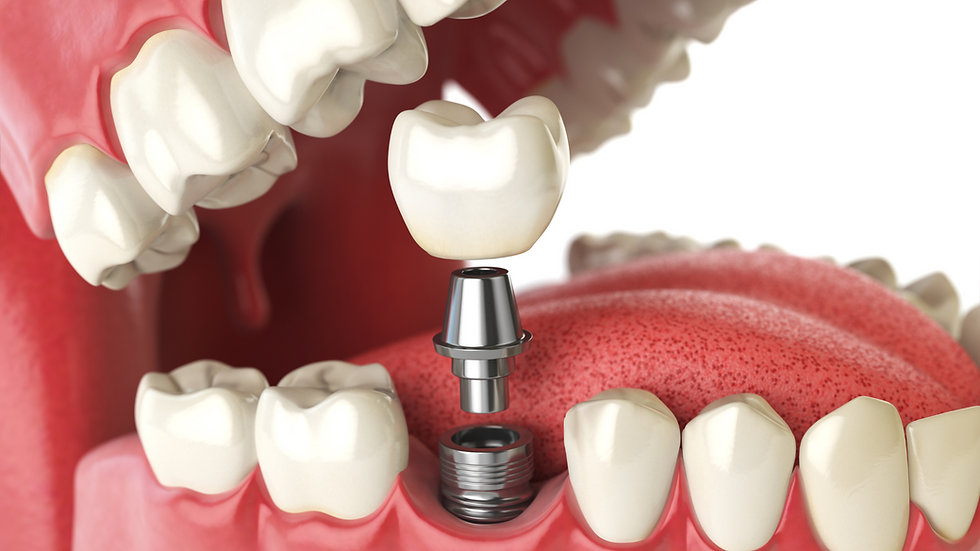top of page
What is Dental Implant?
A dental implant is a very small but strong post made of biocompatible metals, or ceramics, which is inserted into the jaw bone in place of the missing tooth root.
Such an implant acts as a support for the tooth, and is surgically inserted under local anesthetic on an outpatient basis.
Dental implant structure
Implant Post:
Typically made of titanium, the implant post is a screw-like structure surgically inserted into the jawbone, acting as the root of the new tooth. This material is favored for its biocompatibility and ability to integrate with bone through a process called osseointegration.
Abutment:
Once osseointegration is complete, an abutment is attached to the implant post. This connector extends above the gum line and serves as a base for securing the crown.
Crown:
The crown is a custom-made artificial tooth that is affixed to the abutment, completing the restoration. Crowns can be crafted from various materials, including porcelain or ceramic, to closely resemble natural teeth.
Benefits of Dental Implants
Natural Appearance – Implants look and feel like real teeth.
Long-lasting – With proper care, implants can last for decades or even a lifetime.
Bone Preservation – Prevents bone loss caused by missing teeth.
Improved Chewing – Implants are anchored directly into the jawbone, providing a stable solution that does not shift during eating or speaking.
No Impact on Adjacent Teeth – No need to grind down healthy teeth (unlike bridges).
Conventional Treatment VS Implant Treatment
Conventional Treatment | Implant Treatment |
|---|---|

| 
|
Removable Prosthesis
| 
|
Full Prosthesis
| 
|
Surgical Procedure
The dental implant procedure generally unfolds in several stages:
1. Initial Consultation:
A thorough examination, including X-rays and possibly CT scans, is performed to assess bone density and determine the best placement for the implant.
2. Implant Placement:
The first surgical stage involves placing the titanium implant into the jawbone under local anesthesia. This procedure may require minor drilling and sutures.
3. Healing Period:
After placement, a healing period of 3 to 6 months is necessary for osseointegration, during which bone grows around the implant, securing it firmly in place.
4. Abutment Placement:
Once healing is complete, a second procedure may be performed to attach the abutment if it was not placed initially.
5. Crown Attachment:
Finally, after additional healing, the custom crown is secured onto the abutment.
Other methods
Besides the conventional procedures mentioned above, there are some new methods of implant placement which shorten the total time required for treatment and may achieve a better appearance for the false tooth. However, the success rate for the new methods may not be as high as that for the conventional method, and not all cases are suitable.
These are the three common new methods :
● The one-stage surgical procedure is done by placing the healing abutment onto the implant at the same time during the first surgery, which eliminates the need for a second surgery after 3-6 months.
● The immediate implant procedure is done by inserting the implant into the socket immediately or shortly (in few weeks) after extraction. The advantage is not only shorten the whole treatment time required, but also preserve the gum tissue and bone in a better way such that the appearance of the future false teeth can be better. Nevertheless, this method is only suitable for certain cases like no severe inflammation around the extraction tooth, and has sufficient bone thickness around the wound. Therefore, it depends on the dentist’s clinical judgment.
● Minimally invasive dental implant technology, also known as flapless implant surgery, is a modern approach to dental implants that reduces the trauma associated with traditional implant procedures. Minimally invasive dental implants involve placing the implant without the need for extensive gum tissue manipulation. Unlike traditional methods that require cutting and lifting the gum flap, minimally invasive techniques only require a small hole to be drilled in the gum, allowing the implant to be inserted directly into the jawbone. This technique has gained popularity due to its numerous advantages, including smaller incisions, less pain, and quicker recovery times.
Minimally Invasive Dental Implant Technology
Minimally invasive dental implant technology, also known as flapless implant surgery, is a modern approach to dental implants that reduces the trauma associated with traditional implant procedures. Minimally invasive dental implants involve placing the implant without the need for extensive gum tissue manipulation. Unlike traditional methods that require cutting and lifting the gum flap, minimally invasive techniques only require a small hole to be drilled in the gum, allowing the implant to be inserted directly into the jawbone. This technique has gained popularity due to its numerous advantages, including smaller incisions, less pain, and quicker recovery times.
Considerations and Eligibility
Not everyone is an ideal candidate for dental implants. Factors such as bone density, overall health, and lifestyle choices (like smoking) can impact eligibility and healing time. In cases of insufficient bone density, procedures like bone grafting may be necessary to prepare for implant placement.
Points to note after insertion of dental implant
● Teeth must be cleaned thoroughly to prevent infection of tissues around the implant which can cause the implant to loosen.
● Regular recall and cleaning by dental professionals is also very important for the maintenance of dental implant. Besides, it is also necessary to keep good oral hygiene.
FAQs
Q: Does implant surgery hurt?
A:The procedure is done under local anesthesia, with mild discomfort manageable by medication.
Q: How long does the process take?
A: Typically 3-6 months (depending on bone healing).
Q: How much does an implant cost?
A: Costs vary by location, materials, and case complexity—consult your dentist.
bottom of page




